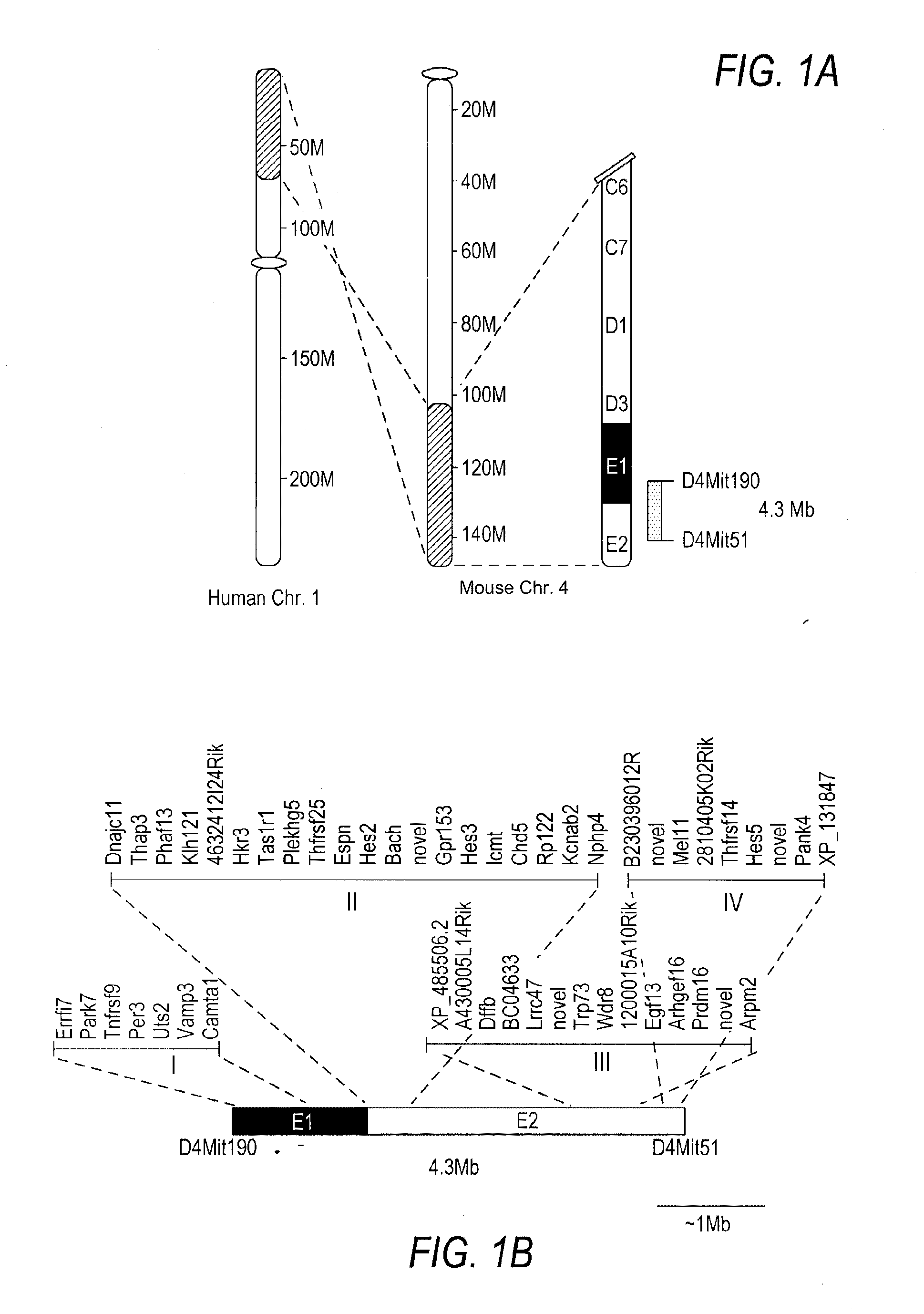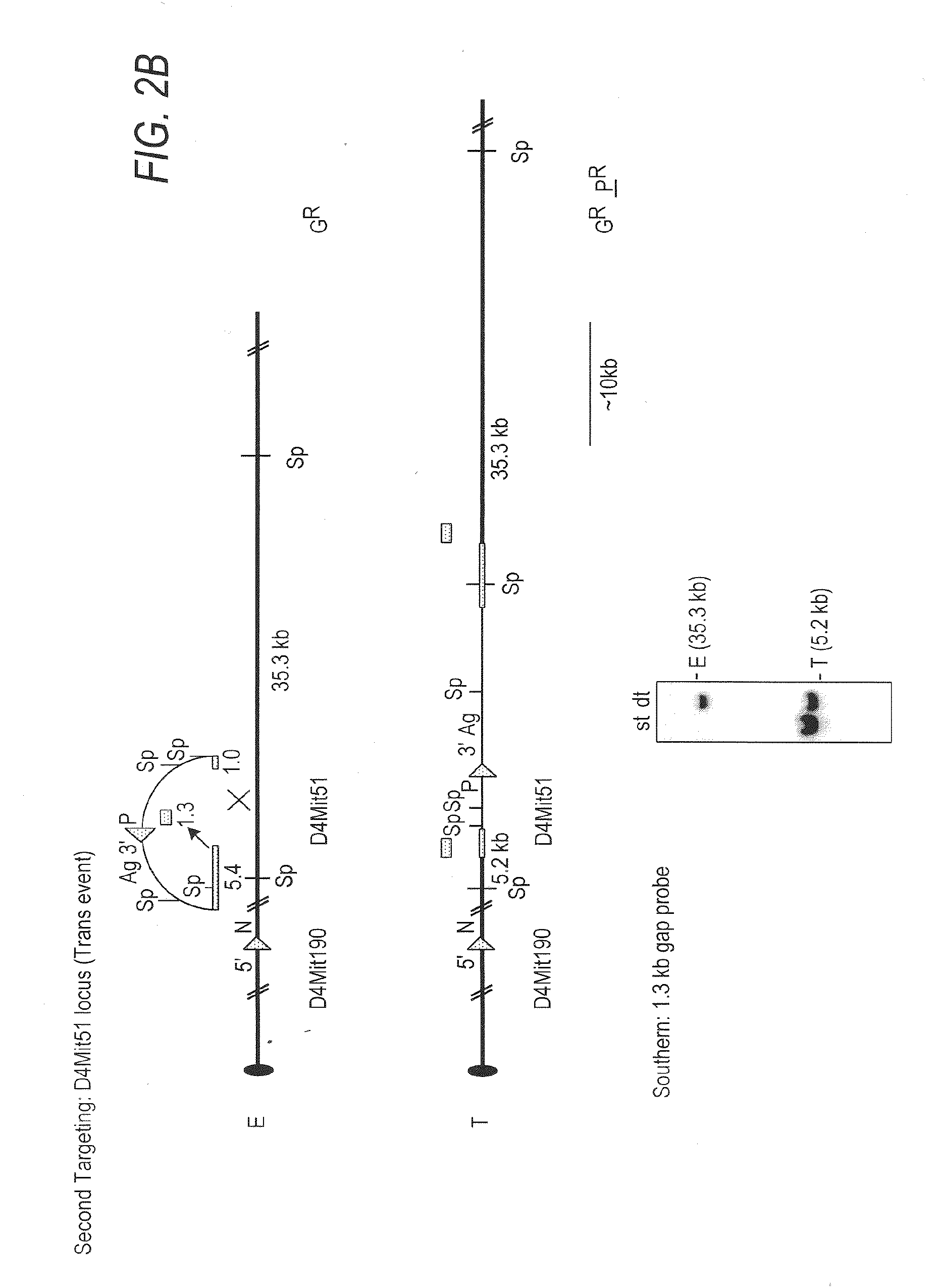Chd5 is a novel tumor suppressor gene
a tumor suppressor and gene technology, applied in the field of chd5 is a novel tumor suppressor gene, can solve the problems of inability to determine which genetic alterations were involved in the initiation of the tumor, the success of tumor suppressors has been limited, and the tumor suppressors have likely eluded detection, so as to improve the chd5 level, induce tumor regression, and prevent tumorigenesis.
- Summary
- Abstract
- Description
- Claims
- Application Information
AI Technical Summary
Benefits of technology
Problems solved by technology
Method used
Image
Examples
example 1
Generation of Mouse Strains with Rearrangements Corresponding to Human 1p36
[0075]To functionally identify novel tumor suppressor genes mapping to human 1p36, mouse strains with defined rearrangements in the corresponding region of the mouse genome were generated using chromosome engineering (FIG. 1A) (Ramirez-Solis et al., 1995, Nature 378, 720-724) reviewed in (Mills, et al., supra). Genes mapping to human 1p36 lie within a conserved linkage group that maps to the distal portion of mouse chromosome 4. Therefore, mouse strains with chromosome engineered deletions (also called deficiencies, df) or duplications (dp) of this region provide genetic models for functionally characterizing genes mapping to human 1p36. Mouse strains harboring df and dp alleles have decreased- and increased dosage of genes mapping within the rearranged interval, respectively.
[0076]The D4Mit190-D4Mit51 region contains the genes shown (FIG. 1B; Table 1). To generate df and dp alleles of this interval, gene tar...
example 2
dp / + mefs have Decreased Proliferation and Enhanced Senescence
[0079]To evaluate the cellular phenotype dp / + mice, we harvested mouse embryonic fibroblasts (mefs) from embryonic day 13.5 (E13.5) embryos obtained from + / + females that had been crossed to df / dp chimeras. Mefs were subjected to a cell proliferation assay in which equivalent numbers of cells were plated and cells were harvested and counted at 2-day intervals (FIG. 3A). While + / + mefs proliferated robustly, dp / + mefs had reduced proliferative potential. To investigate the proliferative defect of dp / + mefs further, flow cytometry was used to determine the population of cells in different stages of the cell cycle (FIG. 3B). While 16.9% of the + / + mef population was in G2 / M, 25.9% of the dp / + mef population was in G2 / M. Consistent with the inability of dp / +mefs to progress through G2 / M, many of the dp / + cells appeared senescent by morphological criteria: they were flattened, enlarged and extended multiple processes. To deter...
example 3
df / + mefs have Enhanced Proliferation, Immortalize and Form Foci Spontaneously
[0080]In contrast to the decreased proliferation of dpi+ mefs, df / + mefs had a significantly enhanced proliferative potential compared to + / + cells (FIG. 3A). In addition, flow cytometry indicated that while 16.9% of the + / + mef population was in G2 / M, only 11.9% of the df / + population was in this phase of the cell cycle (FIG. 3B). To examine whether df / + mefs have an extended cellular lifespan, we used the 3T3 protocol in which an equivalent number of mefs from mice of different genotypes were initially plated, and cells were counted and replated at 3-day intervals (FIG. 3D, upper panel). Wild type- and dp / + mefs could not be maintained for more than 8-10 passages, a finding consistent with previous reports. In contrast to the limited cellular lifespan of + / + and dp / + mefs, df / + mefs could be serially passaged extensively (i.e., 48 times to date) indicating that immortalized cells are easily selected for ...
PUM
| Property | Measurement | Unit |
|---|---|---|
| length | aaaaa | aaaaa |
| resistance | aaaaa | aaaaa |
| proliferation defect | aaaaa | aaaaa |
Abstract
Description
Claims
Application Information
 Login to View More
Login to View More - R&D
- Intellectual Property
- Life Sciences
- Materials
- Tech Scout
- Unparalleled Data Quality
- Higher Quality Content
- 60% Fewer Hallucinations
Browse by: Latest US Patents, China's latest patents, Technical Efficacy Thesaurus, Application Domain, Technology Topic, Popular Technical Reports.
© 2025 PatSnap. All rights reserved.Legal|Privacy policy|Modern Slavery Act Transparency Statement|Sitemap|About US| Contact US: help@patsnap.com



